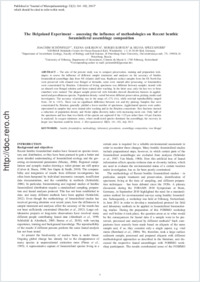The Helgoland Experiment – assessing the influence of methodologies on Recent benthic foraminiferal assemblage composition
- Schönfeld, Joachim GEOMAR Helmholtz Centre for Ocean Research Kiel, Germany
- Golikova, Elena Department of Invertebrate Zoology, Faculty of Biology and Soil Science, St Petersburg State University, Russia
- Korsun, Sergei Department of Invertebrate Zoology, Faculty of Biology and Soil Science, St Petersburg State University, Russia
- Spezzaferri, Silvia Department of Geosciences, University of Fribourg, Switzerland
-
01.07.2013
Published in:
- Journal of Micropalaeontology. - 2013, vol. 32, no. 2, p. 161–182
English
The aim of the present study was to compare preservation, staining and preparation techniques to assess the influence of different sample treatments and analyses on the accuracy of benthic foraminiferal assemblage data from NE Atlantic shelf seas. Replicate surface samples from the SE North Sea were preserved with ethanol–rose Bengal or formalin, some were stained after processing, or foraminifera were concentrated by flotation. Coloration of living specimens was different between samples treated with an ethanol–rose Bengal solution and those stained after washing. In the latter case, only the last two or three chambers were stained. The aliquot sample preserved with formalin showed dissolution features in agglutinated and porcellaneous species. Population density varied between different preservation, picking modes and investigators. The accuracy of picking was in the range of ±2 % (1σ), while external reproducibility ranged from −34 to +16 %. There was no significant difference between wet and dry picking. Samples that were concentrated by flotation generally yielded a lower number of specimens. Agglutinated species were under-represented in samples that were stained after washing and in the flotation concentrate. Size fractions showed a reduction of population density and Fisher alpha diversity index with increasing mesh size. Only half of the specimens and less than two-thirds of the species are captured if the >125 µm rather than >63 µm fraction is analysed. In oxygen minimum zones, where small-sized species dominate the assemblage, the recovery in larger size fractions could be lower.
- Faculty
- Faculté des sciences et de médecine
- Department
- Département de Géosciences
- Language
-
- English
- Classification
- Geology
- License
- License undefined
- Identifiers
-
- RERO DOC 208653
- DOI 10.1144/jmpaleo2012-022
- Persistent URL
- https://folia.unifr.ch/unifr/documents/303325
Statistics
Document views: 64
File downloads:
- spe_hea.pdf: 130
